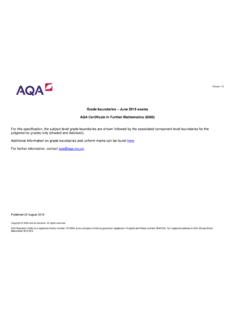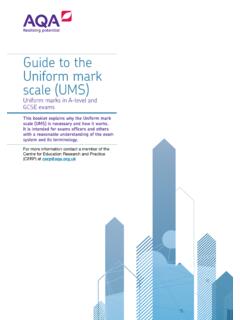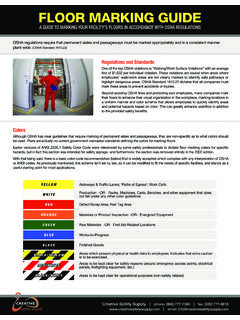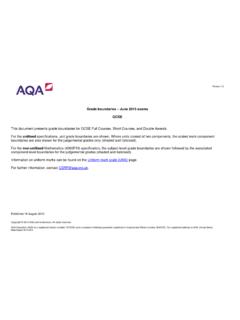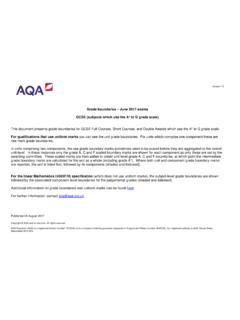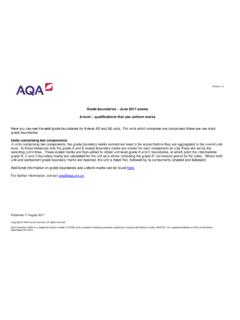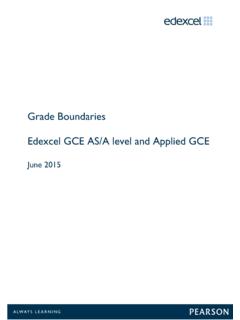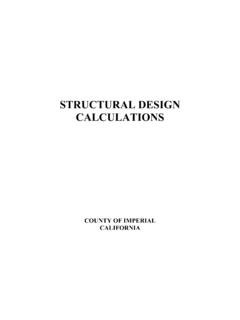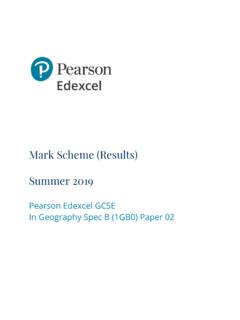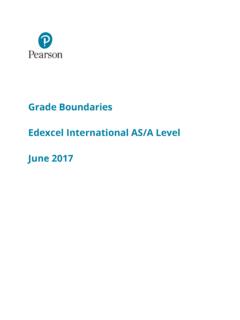Transcription of Grade boundaries for new GCSE English examinations PiXL
1 Grade boundaries for new gcse English examinations pixl pixl has been providing its members with suggested Grade mark ranges for the new gcse English examinations . The following were presented at conferences such as pixl s Great Expectations English Conference on 8th January 2016 and made available widely to members. The number of marks for each Grade has been added. Grade Percentage 9 94% 7 marks 8 83% 11 marks 7 72% 11 marks 6 67% 5 marks 5 63% 4 marks 4 59% 4 marks 3 38% 20 marks 2 27% 11 marks 1 15% 12 marks Subsequently pixl has provided Grade mark ranges for the Language and Literature specifications for each of the gcse Boards. The following are for Edexcel and the others have similar mark distributions. Again, the number of marks for each Grade has been added. pixl : Edexcel English Language 9 94 - 100 7 marks 8 82 - 93 12 marks 7 71 - 81 11 marks 6 67 - 70 4 marks 5 63 - 66 4 marks 4 59 - 62 4 marks 3 42 - 58 17 marks 2 25 - 41 17 marks 1 8 - 24 17 marks pixl : Edexcel English Literature 9 94 - 100 7 marks 8 81 - 93 13 marks 7 68 - 80 13 marks 6 64 - 67 4 marks 5 60 - 63 4 marks 4 56 - 59 4 marks 3 38 - 55 18 marks 2 21 - 37 17 marks 1 4 - 20 17 marks It will be seen that mark distributions are highly implausible with very narrow ranges (usually 4 marks ) for grades 4 to 6 and much wider ranges (mostly between 11 and 20 marks ) for higher and lower grades.
2 No actual gcse examination has ever had such disparate Grade mark ranges. These are always more equal, as shown by the current ranges at Appendix 4 below. pixl has evidently devised their mark ranges by asking member-schools to let them have batches of marked sample papers and collating the marks . They have not taken account of the fact that, when marking a new test of English with multi-mark answers and unfamiliar assessment criteria, English teachers tend to award marks in the middle of mark ranges rather than nearer the upper and lower extremes. Regrettably pixl s proposed Grade mark ranges are highly misleading and, if used, will lead to highly inaccurate Grade predictions. The next 4 pages are extracts from my paper Really raising standards in gcse English (May 2016) available at and from King s College London at A method of deducing more plausible Grade mark ranges from Ofqual s published guidance is given, followed by the outcome (Appendix 3) and a comparison of this with the current uniform Mark Scale used for collating gcse units and with two popular AQA units (Appendix 4).
3 The Grade mark range for Grade 5 is compared with Grade C in red as an example of the higher demand of the new specifications. Laurie Smith (November 2016) Ofqual s indicative Grade boundaries (pages 13 - 15) Ofqual is committed by DFE policy to raising the outcomes of gcse towards the average attainment of 16 year olds in higher-attaining countries such as Finland, Canada, the Netherlands and Switzerland. The new threshold measure will therefore be Grade 5 (the mid- Grade of the new system) which is to be set at the top third of the marks for the current Grade C and the bottom third of the marks for the current Grade B ((Ofqual 2014, paragraph 5a). How this decision affects other Grade boundaries is indicated by the discussion of setting Grade boundaries other than by statistical prediction (Ofqual 2014, paragraphs 88 93) and illustrated by the following diagram at paragraph 91: According to this illustration, Grade 4 requires 56 - 66 per cent, Grade 5 requires 67 - 77 per cent and Grade 6 requires 78 - 88 per cent.)
4 The mark ranges for grades 9 to 7 are therefore 89 - 100 per cent. These will be allocated in the ratios 20:40:40 for English and Mathematics so Grade 7 requires 89 - 93 per cent, Grade 8 requires 94 - 98 per cent and Grade 9 requires 99 100 per cent1. These highest mark ranges may seem extraordinarily narrow and demanding, but they are supported by other evidence discussed below. Ofqual has not clarified the basis for awarding grades 3 1 apart from stating that the same proportion of candidates will receive these grades as are awarded D G at present. 1 The actual mark ranges are Grade 8 = 94 per cent and Grade 9 = 100 per cent, but these have been rounded for practical purposes. As noted in the footnote on page 5, Ofqual is consulting about tailoring the proportions of higher grades to the subject. Ofqual s aim is to provide more discrimination than now in the middle to higher levels of the scale and less discrimination at the lowest levels (paragraph 34).
5 Pending further clarification, it is simplest to treat grades 3 1 as having equal but somewhat wider mark ranges as grades 6 - 4. Grade F and G currently have the same mark-ranges (paragraph 69) and the same principle may apply to all three new grades. Treating 10 per cent as the highest feasible mark for Ungraded as usually at present and dividing 11 to 55 marks in three equal mark-ranges of 15, Grade 1 would require 11 25 per cent, Grade 2 = 26 40 per cent and Grade 3 = 41 55 per cent. These suggested mark ranges are tabulated at Appendix 3. They are then compared with the current uniform Mark Scale (UMS) for reporting gcse grades and with two popular AQA papers in English Language and English Literature (Appendix 4). Grade C and Grade 5 are shown in red to indicate the extent to which Grade 5 will be more demanding than Grade C and the comparative effect of this on other Grade boundaries . APPENDIX 3 OFQUAL S INDICATIVE Grade boundaries (page 14) Grade Mark range (/100) 9 99 100 3 marks 8 94 98 5 marks 7 89 93 5 marks 6 78 88 11 marks 5 67 77 11 marks 4 56 66 11 marks 3 41 55 15 marks 2 26 40 15 marks 1 11 25 15 marks U 0 10 10 marks Notes Mark ranges for grades 6 to 4 are derived from Ofqual s model.
6 Mark ranges for grades 9 to 7 are derived by allocating marks 89 to 100 according to Ofqual s model distribution of these grades as 20:40:40. The narrow mark range for Grade 9 reflects the intense competition for this Grade following from allocating the same proportion of 9 to 7 grades in 2017 as grades A*/A in 2016 but distributed over 3 grades with the lowest proportion allocated to Grade 9. Mark ranges for grades 3 1 are derived by assuming 11 as the lowest mark for a Grade as is common at present and dividing marks 11 to 55 equally. If these mark ranges are valid, the wider mark ranges at grades 1 3 will enable lower ability students to attain the next Grade above expectation more easily than higher ability students competing for grades 7 to 9. Appendix 4 Ofqual s gcse indicative mark ranges compared with current mark ranges (page 14) New Grade Indicative mark range Current Grade uniform Mark Scale (UMS) AQA English Language Unit 3 (ENL03) AQA English Literature Unit 3 (97153)
7 9 8 7 99 100 95 98 89 94 A* A 90 100 80 89 90 100 81 89 90 100 80 89 6 5 4 78 88 67 77 56 66 B C 70 79 60 69 70 80 58 69 65 79 52 64 3 2 1 41 55 26 40 11 25 D E F G 50 59 40 49 30 39 20 29 46 57 35 45 24 34 12 23 40 51 30 39 20 29 10 19 U 0 10 0 19 0 11 0 9 Please note: 1 Ofqual s indicative mark ranges are for grades 4 to 6. The mark ranges for the other grades have been extrapolated as explained on pages 13/14. 2 The uniform Mark Scale is used by all the gcse Awarding Bodies for aggregating and reporting examinations which consist of several papers (units) on a standardised basis.
8 Each qualification is allocated a total uniform mark. For gcse this is typically 200 for a full course and 100 for a short course. The total uniform mark is divided between the papers (units) in proportion to their importance (weighting). For example, in a specification allocated 200 uniform marks which has two equally weighted papers, each paper is allocated 100 uniform marks . If one paper carries three times the weight of the other, it will be allocated 150 uniform marks and the other 50 uniform marks . If a paper is allocated 120 uniform marks , the range of marks allocated to Grade B is 84 to 95 (70% to 79% of 120); for Grade C, 72 to 83 (60% to 69% of 120). 3 The two AQA units give the scaled mark Grade boundaries in 2015 scaled up to 100 per cent by way of illustration. Most of the other units in these examinations consist of higher and lower tiers with different C and D Grade boundaries for each tier. The two units chosen are not tiered.
9 AQA English Language Unit 3 has a top mark of 80, AQA English Literature Unit 3 a top mark of 40. The marks for each Grade boundary have been scaled up as if the top mark in each case is 100 (AQA 2015).

